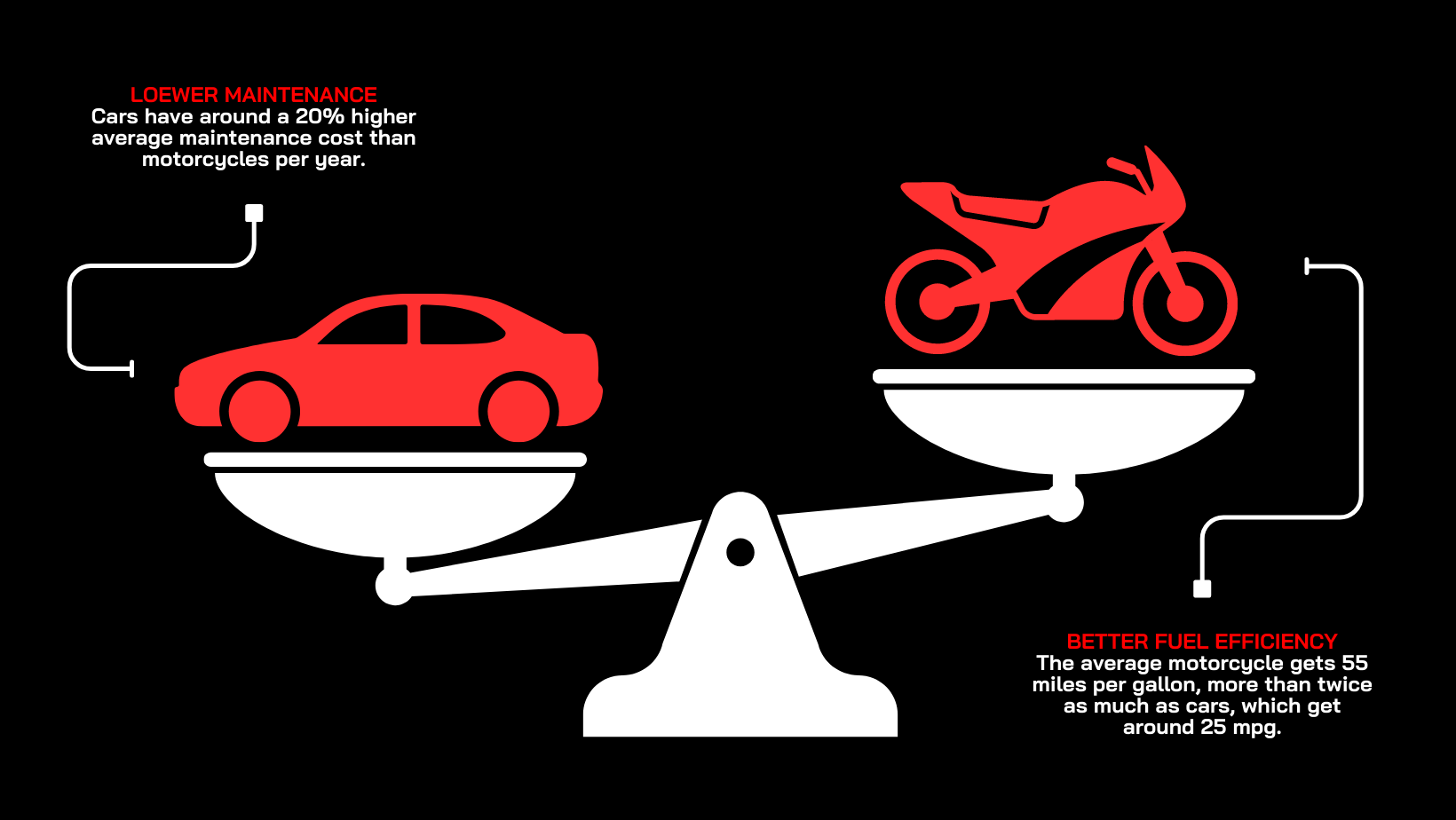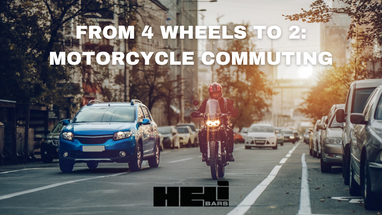Jul 31st 2023
From 4 Wheels to 2: Tips for Smooth Motorcycle Commuting
Nearly 10 million households in America own a motorcycle, and yet for most of them bikes are an auxiliary mode of transportation. In fact, motorcycles as a primary vehicle are so rare that the most recent data on motorcycle commuting is from 2010! At the time, studies found 200,000 motorcycles and scooters were used to travel to and from work daily. But there are many benefits to choosing two wheels over four. In this blog we’ll talk not just about the advantages of motorcycle commuting but the considerations and preparations you’ll need to make before your bike becomes your daily driver.
Benefits of Commuting by Motorcycle
As a motorcycle enthusiast you’re probably already aware of some of the benefits of riding on two wheels—we don’t need to repeat how cool you’ll look—but the impact of those advantages can change in the context of daily commuting. For example, the average motorcycle gets just over 55 miles per gallon, compared to cars which clock in at only 25 mpg. That’s more than twice the distance with the same amount of fuel! Of course, this depends on the type of bike you have, but even manual touring bikes get around 35 mpg on average. While mileage might make little difference when your bike is only used for neighborhood rides or weekend trips, it can be a big boon to your wallet if used regularly.

While the cost benefits are great, not many people consider the physical health benefits too. You don’t need to pedal (and show up to work a sweaty mess) but riding a motorcycle does require fitness, using everything from your arms and legs to hips and back to balance your bike and control your turns. Studies show that you burn between 100 and 300 calories per hour when riding your motorcycle, significantly more than driving a car. When done regularly, motorcycle riding can contribute to improved balance, coordination, and muscle tone.
And yes, commuting by motorcycle can also mean saving time. Depending on the state you live in, lane splitting can allow you to sidestep congested traffic and cut down on your commute. Plus, their small size makes it easier to find parking in urban areas and can even share spaces with other bikes. At the end of the day, motorcycles are also cheaper to maintain as they have fewer parts and repair expenses are typically lower than cars. Plus, if you have a penchant for doing your own motorcycle maintenance, you can save even more on repairs.
All the practical reasons aside, commuting by motorcycle is also just fun! No matter how much you love your job, heading to work every day can still feel like a bummer. By turning one of your favorite hobbies into a piece of your daily routine, you can bring a little joy to your commute. Feel the wind in your hair and all that good stuff. Motorcycle riding also comes with an added community to boost the enjoyment and help you tackle some of the challenges that come with commuting by motorcycle.
Challenges of Motorcycle Commuting
Like with taking up any new activity, it won’t be easy to transition to motorcycle commuting. There are challenges worth considering and work you’ll need to do to ensure your ride is safe and sustainable. Let’s start with the weather… Unless you’ve been driving a convertible, you’re probably used to the comfort of a protected car. Air conditioning, heated seats, the roof over your head will all disappear. There will be days when it’s raining buckets or when the sun is beating down like your boss on a deadline. Not to mention you can get a front row seat to the exhaust from vehicles around you. Variable weather can make motorcycle commuting not only uncomfortable but even dangerous at times.

Speaking of safety, motorcyclists can also be more vulnerable to accidents. Their smaller size makes them difficult for larger vehicles to see in their blind spots and congested roads can be difficult to navigate for less experienced riders. Although riding a motorcycle can be great exercise, doing it daily can also reveal underlying problems with riding comfort that weren’t apparent on shorter, recreational rides. Sore neck, back and wrists aren’t exactly fun to deal with while sitting at your desk or doing physical work. To be a successful motorcycle commuter, you’ll need the skill and right bike fit to ensure your travels are safe and comfortable.
Motorcycles also have limited storage space, which means commuters need to think carefully about how they will transport their items for work like laptops, notes & documents, or even a change of clothes to ensure appropriate dress for the office. Not only is there less space for things, but people too. While only 7.5% of Americans carpool to work to begin with, motorcycles do limit your ability to have passengers.
Tips for a Successful Two Wheel Commute
Making the transition to becoming a motorcycle commuter comes with its share of considerations, but with the right preparations and mindset, it can be an immensely rewarding experience. As we've explored the various advantages and challenges of motorcycle commuting, it's evident that commuting on two wheels offers significant benefits, from cost savings and fuel efficiency to physical health improvements. However, before embarking on your daily two-wheel adventure, it's essential to equip yourself with the knowledge and skills needed for a successful journey. Let’s now delve into the key tips and necessary steps you should take to ensure your motorcycle becomes a reliable and efficient mode of transportation for your daily commute.
- Safety First: Before you start motorcycle commuting, invest in high-quality safety gear, including a DOT-approved helmet, gloves, armored jacket, pants, and boots. Safety should be your top priority on the road. No matter your previous riding experience, consider taking a motorcycle safety course. These courses can improve your riding skills, enhance your road awareness, and make you a more confident and competent rider. Practice before diving in headfirst, getting used to riding on busier roads or at high traffic times in smaller bursts.
- Know Your Route: Plan and test your commuting route on off-days. Look for motorcycle friendly roads and familiarize yourself with any potential traffic bottlenecks or construction areas.
- Be Weather-Prepared: Invest in good-quality waterproof gear for rainy days and consider using cooling vests during hot weather. If needed, bring an extra set of clothes and even shoes that you can change into once you arrive. If your office offers showers, you can also plan to work a quick clean into your morning routine.
- Regular Maintenance: Keep your motorcycle in top condition by adhering to its regular maintenance schedule. Regularly check the tires, brakes, lights, and fluid levels to ensure your bike is safe and reliable.
- Practice Defensive Riding: Always assume that other drivers might not see you on the road. Practice defensive riding by staying alert, maintaining a safe following distance, and anticipating potential hazards.
- Secure Your Belongings: Invest in motorcycle saddlebags, tank bags, or backpacks to securely carry your work essentials. Make sure your belongings are properly secured to the bike and protected from inclement weather.
- Stay Visible: Use your motorcycle's headlights and wear bright, reflective clothing to enhance your visibility, especially during low-light conditions.
- Be Mindful of Lane Splitting Laws: If lane splitting is legal in your state, understand and follow the local laws and guidelines. Never lane split at excessive speeds or in dangerous conditions. Be patient and courteous to other road users. Stay focused and avoid distractions, especially when riding in high traffic areas.
- Stay Fit and Comfortable: Regular motorcycle commuting can take a toll on your body. Strengthen your core muscles to reduce fatigue and evaluate your riding position. Every type of motorcycle pain can be traced back to your posture and motorcycle ergonomics. Invest in ergonomic accessories for your bike like handlebar risers, a new seat, or adjusted foot pegs.
- Be Prepared with Other Transit: There will be times when riding your motorcycle to work just isn’t feasible or safe. If you live in a place with significant snow during the winter, you should plan for alternative transportation like a car or taking public transit. Stay up to date with route closures and have a backup plan in mind.
Ready to embrace your motorcycle as your trusty steed on your daily commute? With movements like “Ride to Work,” perhaps this is the start of a motorcycle commuting revolution. Just remember to be prepared and commit to safety. Do you already commute via motorcycle and have tips to share, challenges you’ve bumped into, or stories of how you started commuting on two wheels? Send us a message with your thoughts and we’ll share them with our community!

